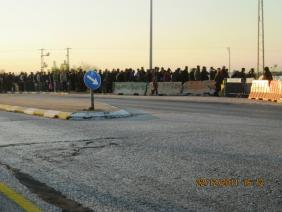'Awarta, 'Azzun 'Atma, Eliyahu Crossing, Habla, Huwwara, Za'tara (Tapuah), Thu 22.12.11, Afternoon
Translator: Charles K.
The usual line at Azzun Atma – about 150 Palestinian laborers returning home forced to wait hours by the side of a heavily-trafficked road, with no shelter over their heads, whatever the weather.


14:00
Habla checkpoint - Vehicles and people on foot manage to go through after being inspected, just before the gate closes.
14:20 Eliyahu crossing – A Hanukkah menorah at the entrance to the checkpoint with holiday greetings from the Shomron regional council. We later see the same thing next to the Palestinian house outside the fence at Azzun Atma.
14:27 Entrance to Azzun village (Highway 55) – Four armed soldiers stand at the entrance gate.
14:45 Jit junction – We didn’t see a parked military vehicle.
At the turn to Highway 60 (toward Huwwara) – installation of nighttime lighting stretching for kilometers is nearing completion, for the settlers of Havat Gil’ad.
14:50 Huwwara checkpoint – A soldier in the guard tower next to the inspection booths. A soldier guards the hitchhiking station at the entrance to the Bracha settlement.
14:55 Awarta checkpoint – The yellow iron bar is closed as usual – no access to

Nablusfrom here.
Large military bulldozers working energetically at the northern entrance to Awarta, creating long, high
earthen berms.
Back to Highway 60 – heavy traffic between Nablusand Ramallah.
15:40 Za’tara checkpoint – Two soldiers at the inspection station. They’re not inspecting.
15:50 Ariel industrial zone –Very large hangers under construction to the north as well as to the south.
16:00 Azzun Atma checkpoint – About 150 Palestinian laborers returning home after a day of work stand in a very long line waiting to be inspected under a canopy sheltering the soldiers (most of whom today wear yarmulkes and earlocks. One speaks in English – a new immigrant).
The laborers are used to the occupation’s tricks – one day there’s no line, the next day there is.
We contact the humanitarian office so they’ll speed up the crossing – “We’re taking care of it,” they respond; “I’ll do the best I can” [Noga], but it doesn’t appear that anything will really help.
.

